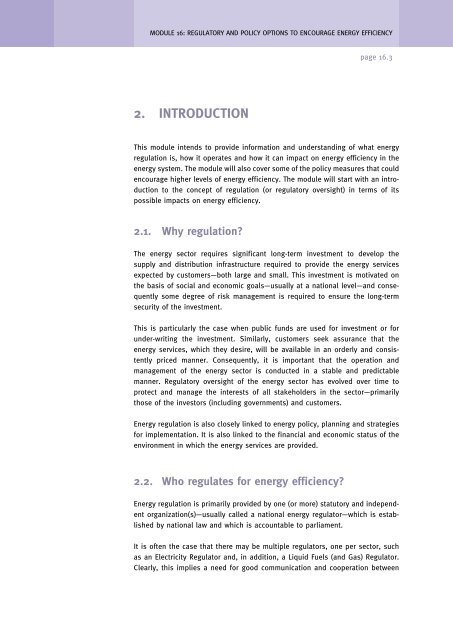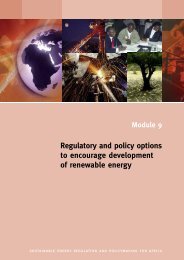Regulatory and policy options to encourage energy efficiency - unido
Regulatory and policy options to encourage energy efficiency - unido
Regulatory and policy options to encourage energy efficiency - unido
You also want an ePaper? Increase the reach of your titles
YUMPU automatically turns print PDFs into web optimized ePapers that Google loves.
MODULE 16: REGULATORY AND POLICY OPTIONS TO ENCOURAGE ENERGY EFFICIENCYpage 16.32. INTRODUCTIONThis module intends <strong>to</strong> provide information <strong>and</strong> underst<strong>and</strong>ing of what <strong>energy</strong>regulation is, how it operates <strong>and</strong> how it can impact on <strong>energy</strong> <strong>efficiency</strong> in the<strong>energy</strong> system. The module will also cover some of the <strong>policy</strong> measures that could<strong>encourage</strong> higher levels of <strong>energy</strong> <strong>efficiency</strong>. The module will start with an introduction<strong>to</strong> the concept of regulation (or regula<strong>to</strong>ry oversight) in terms of itspossible impacts on <strong>energy</strong> <strong>efficiency</strong>.2.1. Why regulation?The <strong>energy</strong> sec<strong>to</strong>r requires significant long-term investment <strong>to</strong> develop thesupply <strong>and</strong> distribution infrastructure required <strong>to</strong> provide the <strong>energy</strong> servicesexpected by cus<strong>to</strong>mers—both large <strong>and</strong> small. This investment is motivated onthe basis of social <strong>and</strong> economic goals—usually at a national level—<strong>and</strong> consequentlysome degree of risk management is required <strong>to</strong> ensure the long-termsecurity of the investment.This is particularly the case when public funds are used for investment or forunder-writing the investment. Similarly, cus<strong>to</strong>mers seek assurance that the<strong>energy</strong> services, which they desire, will be available in an orderly <strong>and</strong> consistentlypriced manner. Consequently, it is important that the operation <strong>and</strong>management of the <strong>energy</strong> sec<strong>to</strong>r is conducted in a stable <strong>and</strong> predictablemanner. <strong>Regula<strong>to</strong>ry</strong> oversight of the <strong>energy</strong> sec<strong>to</strong>r has evolved over time <strong>to</strong>protect <strong>and</strong> manage the interests of all stakeholders in the sec<strong>to</strong>r—primarilythose of the inves<strong>to</strong>rs (including governments) <strong>and</strong> cus<strong>to</strong>mers.Energy regulation is also closely linked <strong>to</strong> <strong>energy</strong> <strong>policy</strong>, planning <strong>and</strong> strategiesfor implementation. It is also linked <strong>to</strong> the financial <strong>and</strong> economic status of theenvironment in which the <strong>energy</strong> services are provided.2.2. Who regulates for <strong>energy</strong> <strong>efficiency</strong>?Energy regulation is primarily provided by one (or more) statu<strong>to</strong>ry <strong>and</strong> independen<strong>to</strong>rganization(s)—usually called a national <strong>energy</strong> regula<strong>to</strong>r—which is establishedby national law <strong>and</strong> which is accountable <strong>to</strong> parliament.It is often the case that there may be multiple regula<strong>to</strong>rs, one per sec<strong>to</strong>r, suchas an Electricity Regula<strong>to</strong>r <strong>and</strong>, in addition, a Liquid Fuels (<strong>and</strong> Gas) Regula<strong>to</strong>r.Clearly, this implies a need for good communication <strong>and</strong> cooperation between










